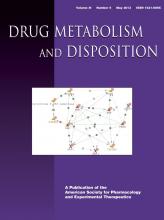Abstract
Characterization of the circulating metabolites for a new chemical entity in humans is essential for safety assessment, an understanding of their contributions to pharmacologic activities, and their potential involvement in drug-drug interactions. This review examines the abundance of metabolites relative to the total parent drug [metabolite-to-parent (M/P) ratio] from 125 drugs in relation to their structural and physicochemical characteristics, lipoidal permeability, protein binding, and fractional formation from parent (fm). Our analysis suggests that fm is the major determinant of total drug M/P ratio for amine, alcohol, N- and S-oxide, and carboxylic acid metabolites. Passage from the hepatocyte to systemic circulation does not appear to be limiting owing to the vast majority of metabolites formed being relatively lipid permeable. In some cases, active transport plays an important role in this process (e.g., carboxylic acid metabolites). Differences in total parent drug clearance and metabolite clearance are attenuated by the reduction in lipophilicity introduced by the metabolic step and resultant compensatory changes in unbound clearance and protein binding. A small subclass of these drugs (e.g., terfenadine) is unintentional prodrugs with very high parent drug clearance, resulting in very high M/P ratios. In contrast, arenol metabolites show a more complex relationship with fm due largely to the new metabolic routes (conjugation) available to the metabolite compared with the parent drug molecule. For these metabolites, a more thorough understanding of the elimination clearance of the metabolite is critical to discern the likelihood of whether the phenol will constitute a major circulating metabolite.
Footnotes
- Received November 20, 2012.
- Accepted March 1, 2013.
↵
 This article has supplemental material available at dmd.aspetjournals.org.
This article has supplemental material available at dmd.aspetjournals.org.
- Copyright © 2013 by The American Society for Pharmacology and Experimental Therapeutics
DMD articles become freely available 12 months after publication, and remain freely available for 5 years.Non-open access articles that fall outside this five year window are available only to institutional subscribers and current ASPET members, or through the article purchase feature at the bottom of the page.
|







